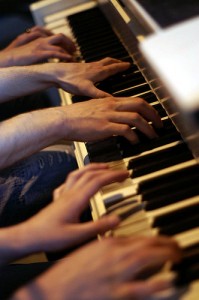The mysterious process by which an ordinary cell can be transformed into a pluripotent stem cell just got a little clearer. Researchers in Children’s Stem Cell Program have, with collaborators, found that a set of genetic elements called large intergenic non-coding RNAs, or lincRNAs, are involved in the “reprogramming” process.
LincRNAs, like other RNAs that don’t code for proteins, once flew under the scientific radar but are now known to have important biologic functions. They help orchestrate which genes inside a cell are expressed, or copied into messenger RNAs, which provide templates for the corresponding proteins – in this case, proteins that determine pluripotency.
George Daley of Children’s, one of the paper’s two senior authors, hopes the new findings will help fine-tune the process of creating pluripotent stem cells from patients’ skin or blood cells. They come on the heels of another groundbreaking discovery: in September, Derrick Rossi and colleagues at the Program in Cellular and Molecular Medicine at Children’s reported that cells can be reprogrammed to pluripotency – or, conversely, to different specialized cell types – more efficiently and safely than current virus-based methods by using artificially modified messenger RNAs.
The new paper, published in Nature Genetics, suggests that lincRNAs are part of the natural cell reprogramming process, so may help refine Rossi’s method. “This finding gives us another set of fingers to play on the genomic piano that controls the ‘music’ of cellular reprogramming,” co-senior author John Rinn, of the Broad Institute and Beth Israel Deaconness Medical Center, told the Harvard Gazette.
If there are more fingers on the piano, there are also other instruments in the regenerative medicine symphony. Late last month, Children’s surgeon Dario Fauza, also an affiliate member of Children’s Stem Cell Program, reported that multipotent mesenchymal stem cells (MSCs), isolated from the amniotic fluid that bathes the developing fetus, have powerful wound-healing properties in utero that could perhaps be harnessed for regenerative treatments after birth. He envisions a future in which amniotic MSCs are banked after amniocentesis, to fix congenital defects and more. But he would also like to find out how the cells do their healing, and what factors they secrete that could be used as direct treatments.
Last year, a related study from another affiliated lab, led by Stella Kourembanas, chief of Children’s Division of Newborn Medicine, found that bone marrow stromal cells, a type of stem cell with the potential to form lung cells, were able to protect the lungs of newborn mice from injury. But the media in which the stem cells were grown – with the actual cells removed – also had a protective effect, possibly even greater than that of the cells themselves.
Embryonic stem cells, induced pluripotent stem cells, fetal stem cells, adult stem cells, growth factors. Some of these instruments may turn out to be minor players, but the song remains the same: observing and tapping the existing powers of nature to heal patients young and old.







